Case Study on Water Quality Improvement in Xihu Lake through Diversion and Water Distribution
Abstract
:1. Introduction
2. Materials and Methods
2.1. Study Area
2.2. Requirements for Diversion and Water Distribution
2.3. Hydrological Calculations of Diversion Discharge
2.4. Data Collection and Measurement
3. Results and Discussion
3.1. Demonstrative Project in Beili Lake
3.2. Field Observations after the Implementation of the Project
3.3. Flow Field Improvement and Velocity Increment
3.4. Transparency Improvement
3.5. Pollutants Reduction
4. Conclusions
Acknowledgments
Author Contributions
Conflicts of Interest
References
- Smith, V.H.; Schindler, D.W. Eutrophication science: Where do we go from here? Trends Ecol. Evol. 2009, 24, 201–207. [Google Scholar] [CrossRef] [PubMed]
- Qin, B.; Zhu, G.; Gao, G.; Zhang, Y.; Wei, L.; Paerl, H.W.; Carmichael, W.W. A drinking water crisis in Lake Taihu, China: Linkage to climatic variability and lake management. Environ. Manag. 2010, 45, 105–112. [Google Scholar] [CrossRef] [PubMed]
- Beklioğlu, M.; Bucak, T.; Coppens, J.; Bezirci, G.; Tavşanoğlu, Ü.N.; Çakıroğlu, A.İ.; Levi, E.E.; Erdoğan, Ş.; Filiz, N.; Özkan, K.; et al. Restoration of eutrophic lakes with fluctuating water levels: A 20-Year monitoring study of two Inter-Connected lakes. Water 2017, 9, 127. [Google Scholar] [CrossRef]
- Welch, E.B.; Cooke, G.D. Internal phosphorus loading in shallow lakes: Importance and control. Lake Reserv. Manag. 2005, 11, 273–281. [Google Scholar] [CrossRef]
- Norris, B.; Laws, E.A. Nutrients and phytoplankton in a shallow, hypereutrophic urban ake: Prospects for restoration. Water 2017, 9, 431. [Google Scholar] [CrossRef]
- Donabaum, K.; Schagerl, M.; Dokulil, M.T. Integrated management to restore macrophyte domination. Hydrobiologia 1999, 395/396, 87–97. [Google Scholar] [CrossRef]
- Mitsch, W.J.; Gosselink, J.G. Wetlands, 4th ed.; John Wiley & Sons, Inc.: New York, NY, USA, 2007; 582p, ISBN 978-0-471-69967-5. [Google Scholar]
- Mander, U.; Mitsch, W.J. Pollution control by wetlands. Ecol. Eng. 2009, 35, 153–158. [Google Scholar] [CrossRef]
- Sierp, M.T.; Qin, J.G.; Recknagel, F. Biomanipulation: A review of biological control measures in eutrophic waters and the potential for murray cod Maccullochella peelii peelii, to promote water quality in temperate Australia. Rev. Fish Biol. Fish. 2009, 19, 143–165. [Google Scholar] [CrossRef]
- Ying, A.; Bi, Y.; Hu, Z. Response of predominant phytoplankton species to anthropogenic impacts in Lake Taihu. J. Freshw. Ecol. 2015, 30, 99–112. [Google Scholar] [CrossRef]
- Jeppesen, E.; Søndergaard, M.; Meerhoff, M.; Lauridsen, T.L.; Jensen, J.P. Shallow lake restoration by nutrient loading reduction—Some recent findings and challenges ahead. Hydrobiologia 2007, 584, 239–252. [Google Scholar] [CrossRef]
- Winks, A.; Tian, K.; Liu, Y. Water Eutrophication Prevention by Phoslock Flocculation and Sediment Capping Reaction. In Proceedings of the International Conference on Environmental Science and Information Application Technology, Wuhan, China, 4–5 July 2009; Volume 1, pp. 349–352. [Google Scholar]
- Reitzel, K.; Lotter, S.; Dubke, M.; Egemose, S.; Jensen, H.S.; Andersen, F.Ø. Effects of phoslock®, treatment and chironomids on the exchange of nutrients between sediment and water. Hydrobiologia 2013, 703, 189–202. [Google Scholar] [CrossRef]
- Oglesby, R.T. Effects of controlled nutrient dilution on the eutrophication of a lake. In Eutrophication: Causes, Consequences, Correctives; Proceedings of a Symposium; National Academy of Sciences: Washington, DC, USA, 1969. [Google Scholar]
- Hosper, H.; Meyer, M.L. Control of phosphorus loading and flushing as restoration methods for Lake Veluwe, The Netherlands. Aquat. Ecol. 1986, 20, 183–194. [Google Scholar] [CrossRef]
- Vanderdoes, J.; Verstraelen, P.; Boers, P.; Vanroestel, J.; Roijackers, R.; Moser, G. Lake restoration with and without dredging of phosphorus-enriched upper sediment layers. Hydrobiologia 1992, 233, 197–210. [Google Scholar] [CrossRef]
- Moss, B.; Stansfield, J.; Irvine, K.; Perrow, M.; Phillips, G. Progressive restoration of a shallow lake: A 12-year experiment in isolation, sediment removal and biomanipulation. J. Appl. Ecol. 1996, 33, 71–86. [Google Scholar] [CrossRef]
- Hu, W.; Zhai, S.; Zhu, Z.; Han, H. Impacts of the Yangtze River water transfer on the restoration of Lake Taihu. Ecol. Eng. 2008, 34, 30–49. [Google Scholar] [CrossRef]
- James, R.T.; Pollman, C.D. Sediment and nutrient management solutions to improve the water quality of Lake Okeechobee. Lake Reserv. Manag. 2011, 27, 28–40. [Google Scholar] [CrossRef]
- Wu, J.; Wang, R.; Yu, J.Y.; Yu, Z.M.; Shen, X.D. Macrozoobenthos communities of West Lake after drawing fresh water from Qiantang River. Environ. Pollut. Control 1999, 21, 25–29. (In Chinese) [Google Scholar] [CrossRef]
- Gao, X.; Xu, L.; Zhang, C. Modelling the effect of water diversion projects on renewal capacity in an urban artificial lake in China. J. Hydroinform. 2015, 17, 990–1002. [Google Scholar] [CrossRef]
- Welch, E.B.; Barbiero, R.P.; Bouchard, D.; Jones, C.A. Lake trophic state change and constant algal composition following dilution and diversion. Ecol. Eng. 1992, 1, 173–197. [Google Scholar] [CrossRef]
- Hu, L.; Hu, W.; Zhai, S. Effects on water quality following water transfer in Lake Taihu, China. Ecol. Eng. 2010, 36, 471–481. [Google Scholar] [CrossRef]
- Welch, E.B.; Patmont, C.R. Lake restoration by dilution: Moses Lake, Washington. Water Res. 1980, 14, 1317–1325. [Google Scholar] [CrossRef]
- Welch, E.B. Phosphorus reduction by dilution and shift in fish species in Moses Lake, WA. Lake Reserv. Manag. 2009, 25, 276–283. [Google Scholar] [CrossRef]
- Lane, R.R.; Day, J.W., Jr.; Kemp, G.P.; Demcheck, D.K. The 1994 experimental opening of the Bonnet Carre Spillway to divert Mississippi River water into Lake Pontchartrain, Louisiana. Ecol. Eng. 2001, 17, 411–422. [Google Scholar] [CrossRef]
- Mishra, D.R.; Mishra, S. Plume and bloom: Effect of the Mississippi River diversion on the water quality of Lake Pontchartrain. Geocarto Int. 2010, 25, 555–568. [Google Scholar] [CrossRef]
- Jagtman, D.; Van der Molen, D.T.; Vermij, S. The influence of flushing on nutrient dynamics, composition and densities of algae and transparency in Veluwemeer, The Netherlands. Hydrobiologia 1992, 233, 187–196. [Google Scholar] [CrossRef]
- Das, D.K. Environmental Impact of Inter-Basin Water Transfer Projects: Some Evidence from Canada. Econ. Polit. Wkly. 2006, 41, 1703–1707. [Google Scholar]
- Miao, Z.L. Diversion works of channelling water into the lakes in Guilin. J. Guilin Inst. Technol. 2000, 20, 371–374. (In Chinese) [Google Scholar] [CrossRef]
- Hua, Z.L.; Gu, L.; Xue, H.; Liu, X.D. Assessing indicators for water diversion based on improving water quality of shallow lakes. J. Lake Sci. 2008, 5, 623–629. (In Chinese) [Google Scholar] [CrossRef]
- Jia, S.; You, Y.; Wang, R. Influence of water diversion from Yangtze River to Taihu Lake on nitrogen and phosphorus concentrations in different water areas. Water Resour. Prot. 2008, 24, 53–56. (In Chinese) [Google Scholar] [CrossRef]
- Zheng, J.Z.; Wang, L.; You, Z.Y.; Jiang, R.D. Influence of water diversion and drainage on lake current of Wuxi Watershed in Taihu Lake Basin. Autom. Water Resour. Hydrol. 2009, 4, 47–50. (In Chinese) [Google Scholar] [CrossRef]
- Zeng, H.; Wu, J. Tracing the Nitrate Sources of the Yili River in the Taihu Lake Watershed: A Dual Isotope Approach. Water 2015, 7, 188–201. [Google Scholar] [CrossRef]
- Li, Y.; Tang, C.; Wang, C.; Tian, W.; Pan, B.; Hua, L.; Lau, J.; Yu, Z.; Acharya, K. Assessing and modeling impacts of different inter-basin water transfer routes on Lake Taihu and the Yangtze River, China. Ecol. Eng. 2013, 60, 399–413. [Google Scholar] [CrossRef]
- Huang, J.; Gao, J.; Zhang, Y.; Xu, Y. Modeling impacts of water transfers on alleviation of phytoplankton aggregation in Lake Taihu. J. Hydroinform. 2015, 119, 329–337. [Google Scholar] [CrossRef]
- Li, Y.; Tang, C.; Wang, C.; Anim, D.O.; Yu, Z.; Acharya, K. Improved Yangtze River Diversions: Are they helping to solve algal bloom problems in Lake Taihu, China? Ecol. Eng. 2013, 51, 104–116. [Google Scholar] [CrossRef]
- Zhai, S.; Hu, W.; Zhu, Z. Ecological impacts of water transfers on Lake Taihu from the Yangtze River, China. Ecol. Eng. 2010, 36, 406–420. [Google Scholar] [CrossRef]
- Li, Y.P.; Acharya, K.; Chen, D.; Stone, M. Modeling water ages and thermal structure of Lake Mead under changing water levels. Lake Reserv. Manag. 2010, 26, 258–272. [Google Scholar] [CrossRef]
- Yu, J.J. Effects of water transfer on water quality improvement in Xihu Lake, a review. Water Resour. Prot. 1998, 2, 50–55. (In Chinese) [Google Scholar]
- General Bureau of China National Environmental Protection. National Environmental Protection Standard (GHZB 1-1999): Environmental Quality Standard for Surface Water; General Bureau of China National Environmental Protection: Beijing, China, 2000.
- Lambert, S.J.; Davy, A.J. Water quality as a threat to aquatic plants: Discriminating between the effects of nitrate, phosphate, boron and heavy metals on charophytes. New Phytol. 2011, 189, 1051–1059. [Google Scholar] [CrossRef] [PubMed]
- Luo, Z. Prediction of sedimentation for the navigation channel of a tidal inlet with mouth bar. IRTCES. In Proceedings of the 4th International Symposium on River Sedimentation, Beijing, China, 5–9 June 1989; China Ocean Press: Beijing, China, 1989; pp. 5–9. [Google Scholar]
- Luo, Z. Sediment transportation under wind, wave and tidal current. Hydro-Sci. Eng. 2004, 3, 1–6. (In Chinese) [Google Scholar] [CrossRef]
- Ministry of Communications of PRC. Technological Specification of Harbour Engineering (JTJ221-87); China Communications Press: Beijing, China, 1988. (In Chinese) [Google Scholar]
- Yan, K. Coastal Engineering; China Ocean Press: Beijing, China, 2002; ISBN 9787502754730. (In Chinese) [Google Scholar]
- Teng, X.; Wu, X.; Dong, J. A method of calculating wind wave elements. J. Oceanogr. Huanghai Bohai Seas 1985, 3, 5–17. (In Chinese) [Google Scholar]
- Cao, W.; Li, J.; Li, K.; Peng, Y. The measurement of sediment concentration using the turbidity measuring method and its applications. In Proceedings of the 8th National Symposium on Environmental and Ecological Hydraulics, Anshun, China, 1 September 2008; China Water & Power Press: Beijing, China, 2008; pp. 103–108. (In Chinese). [Google Scholar]
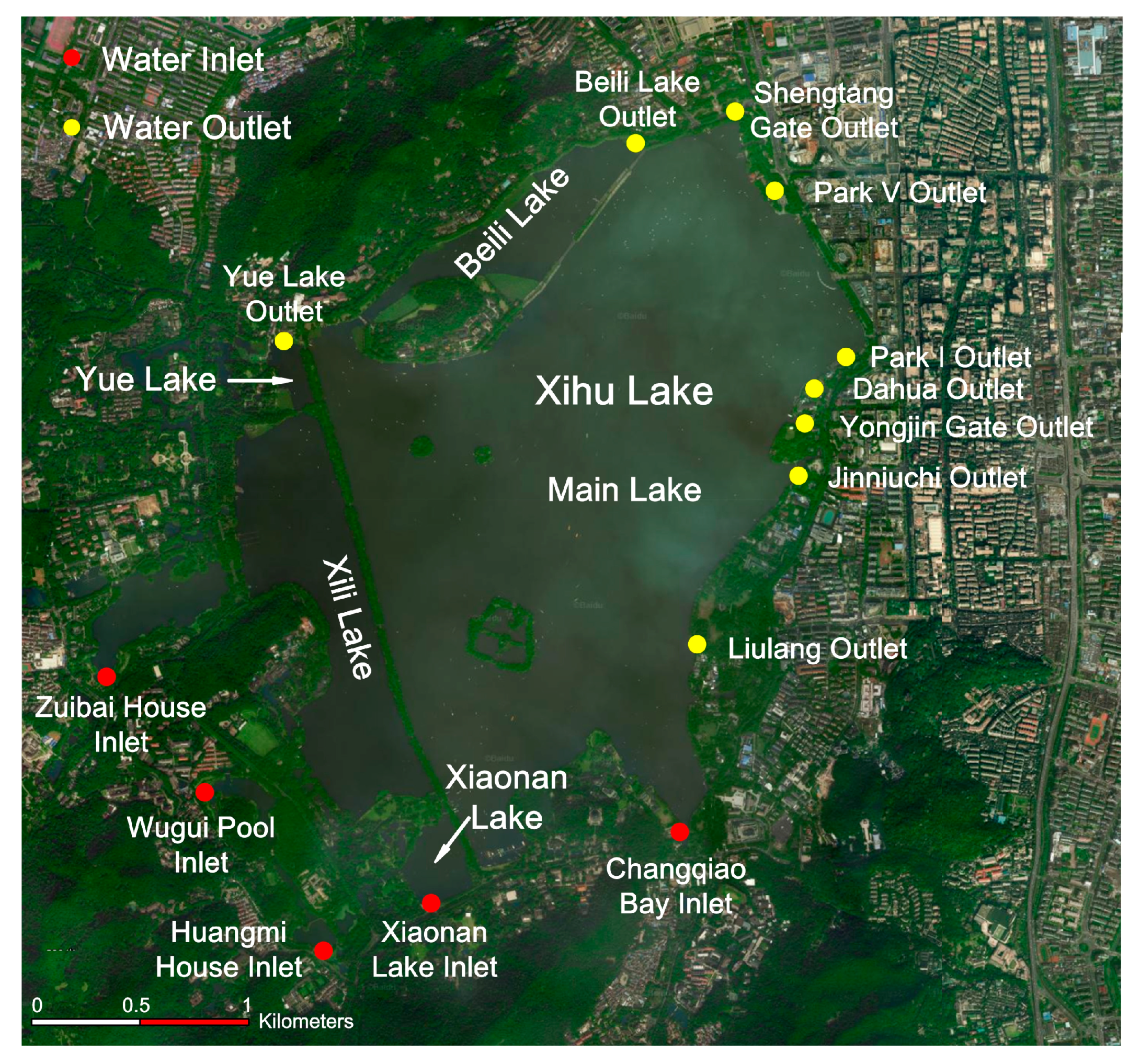
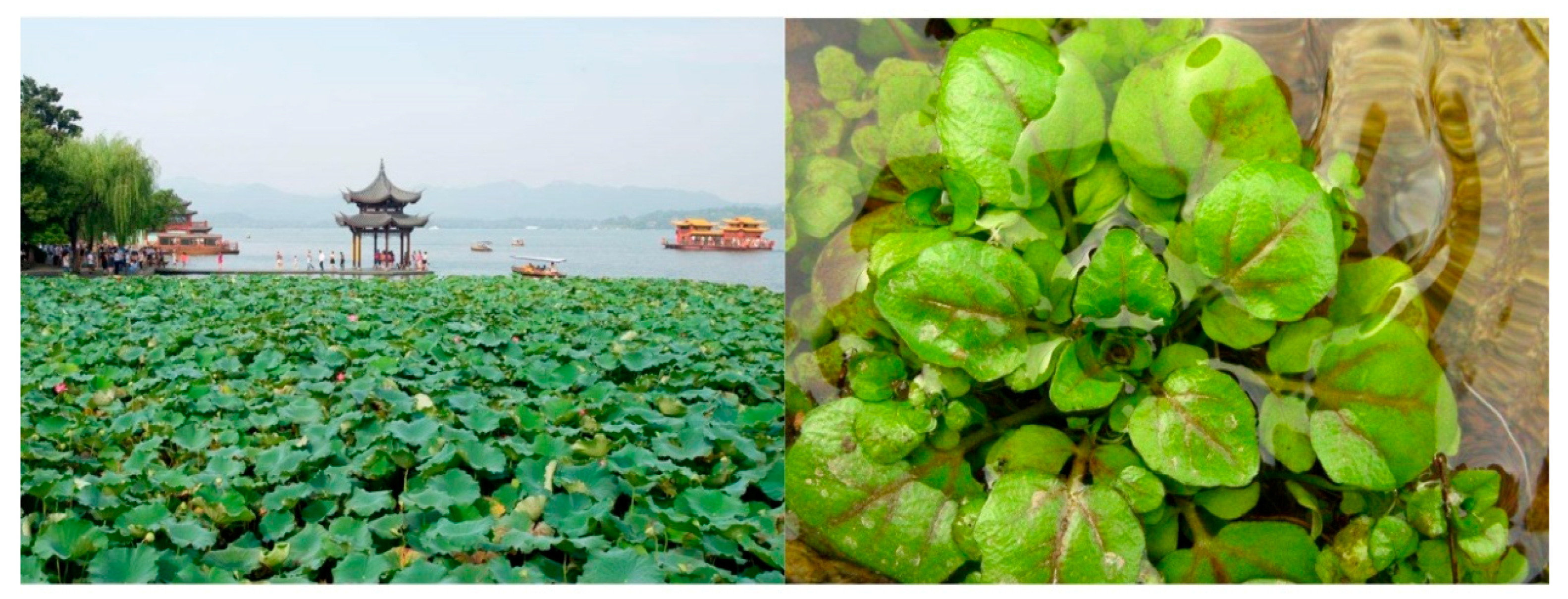
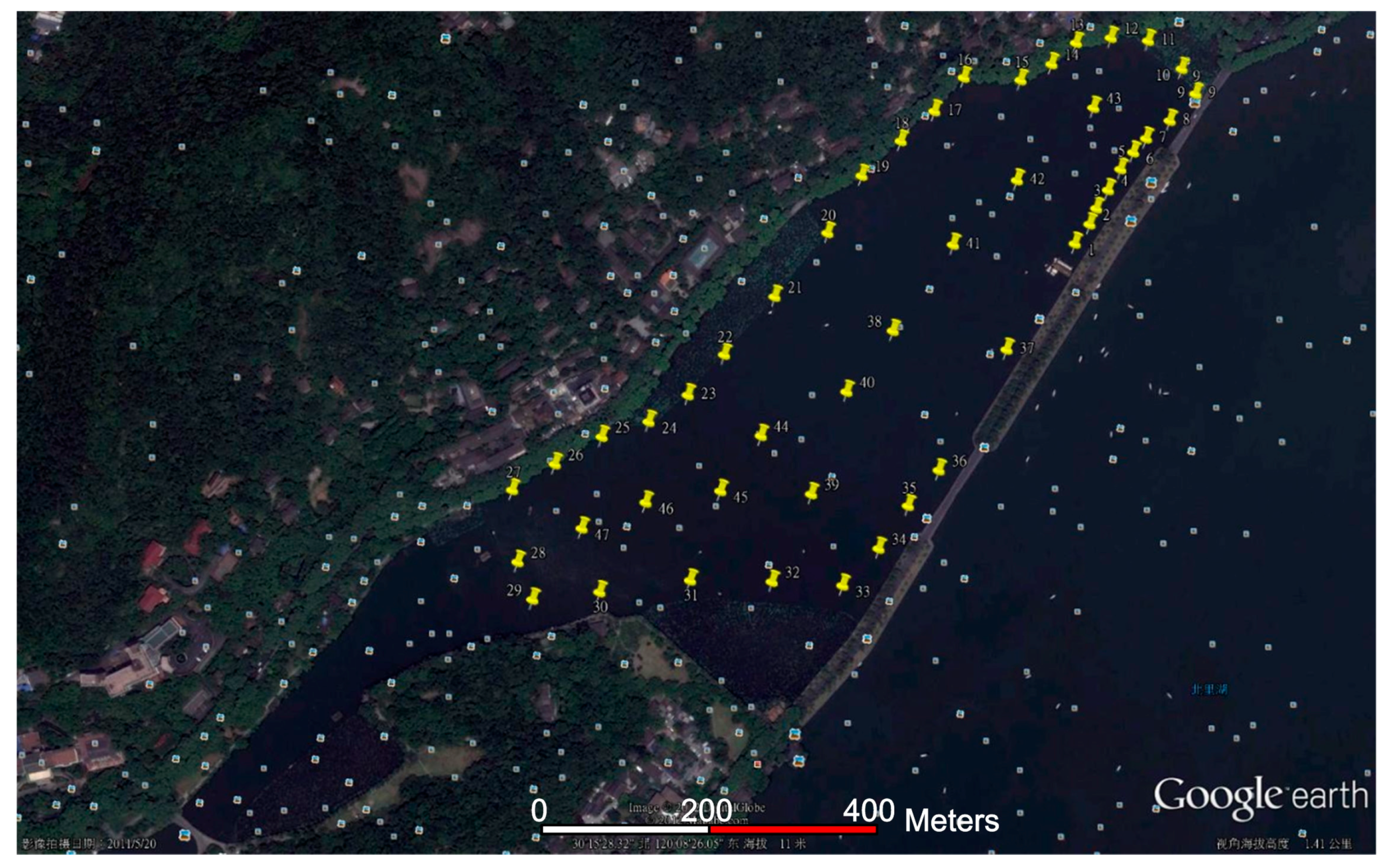
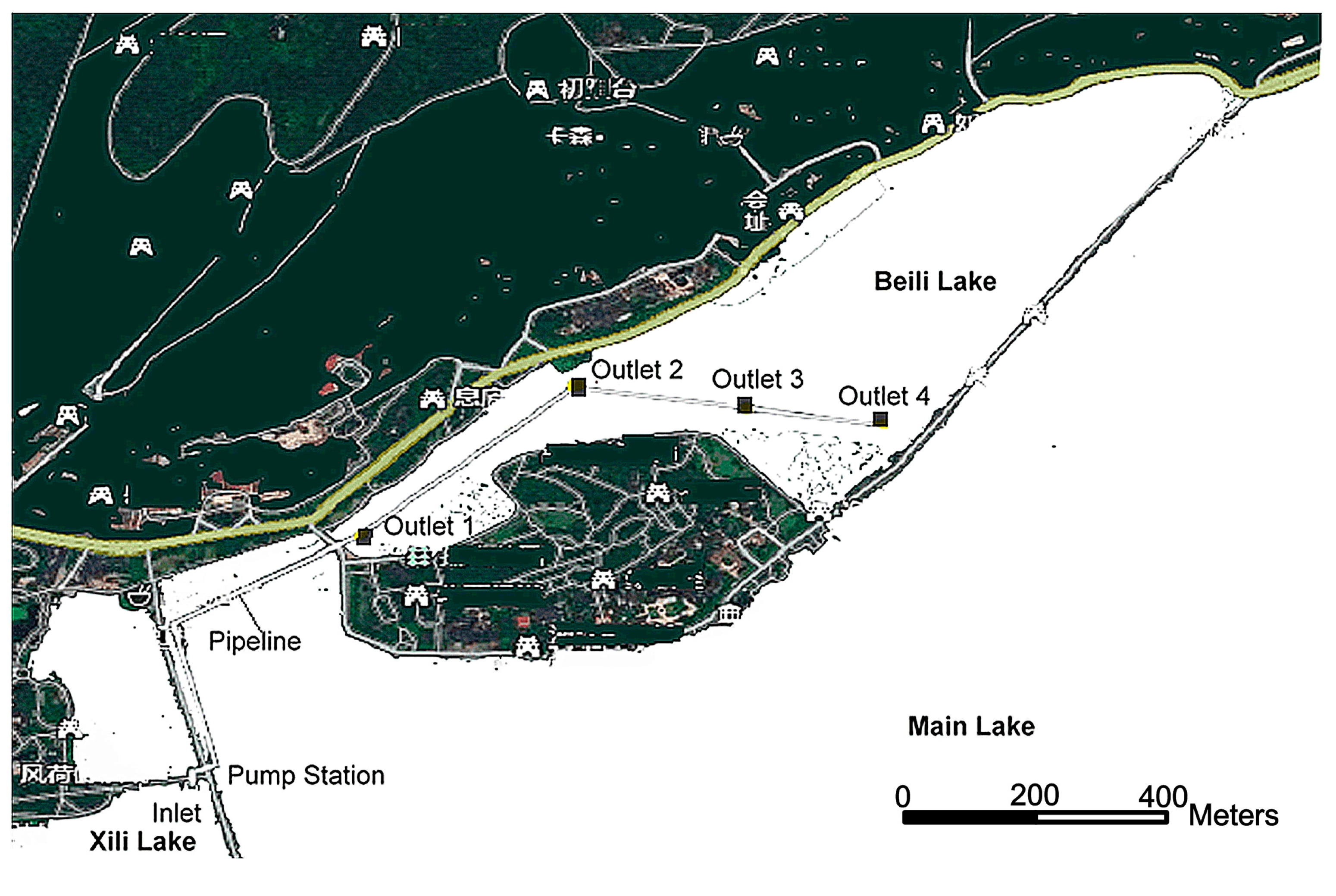
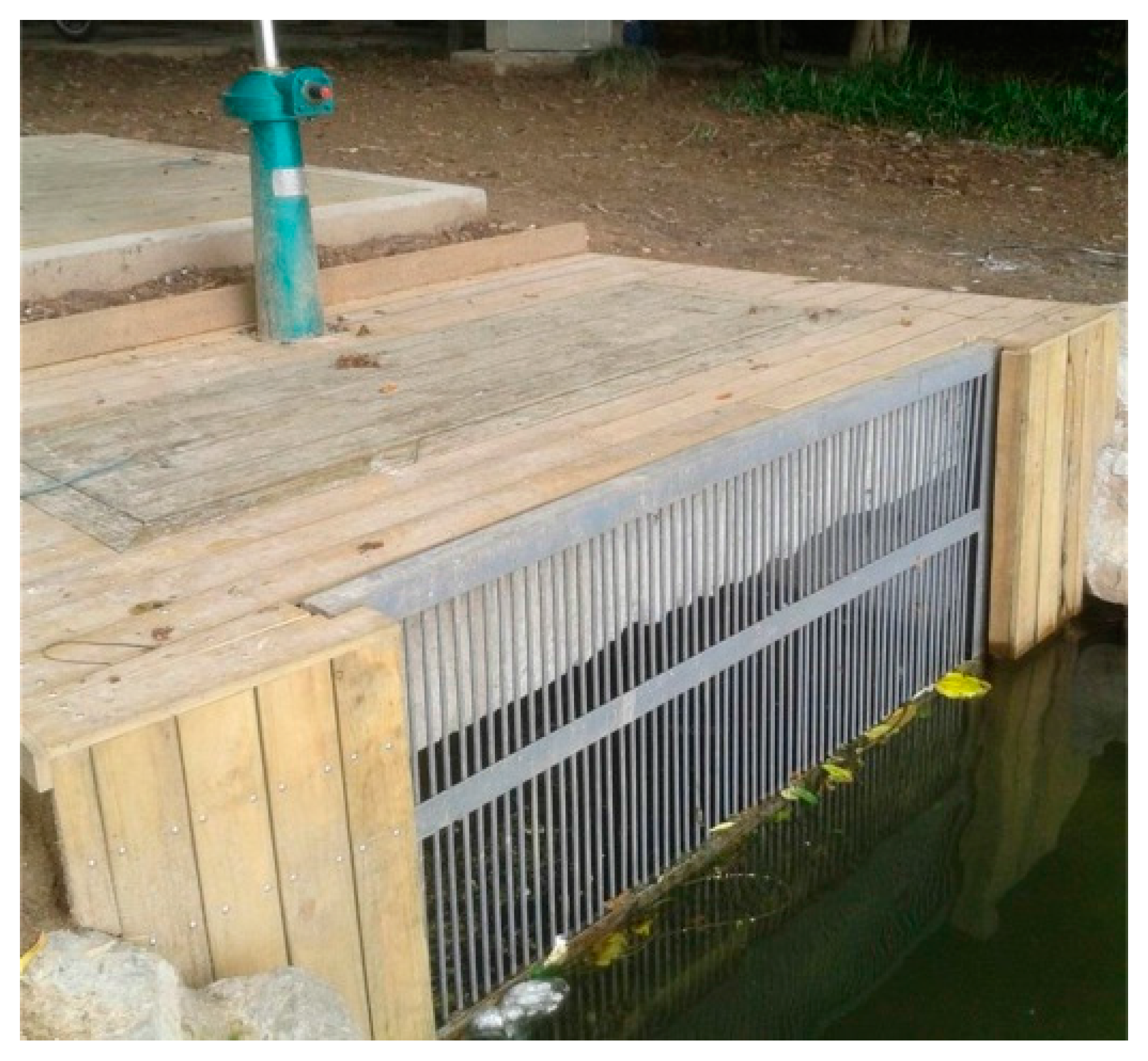
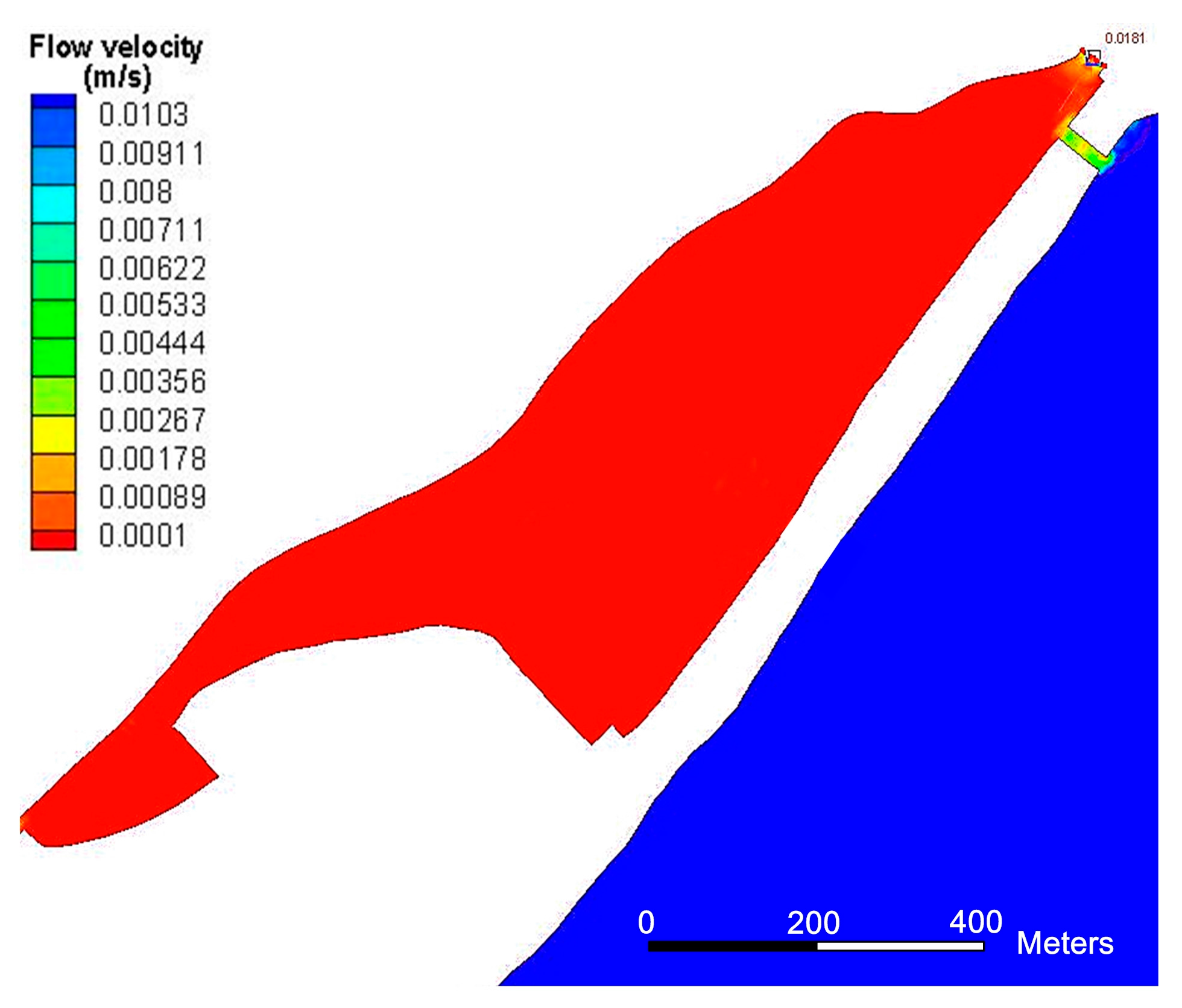
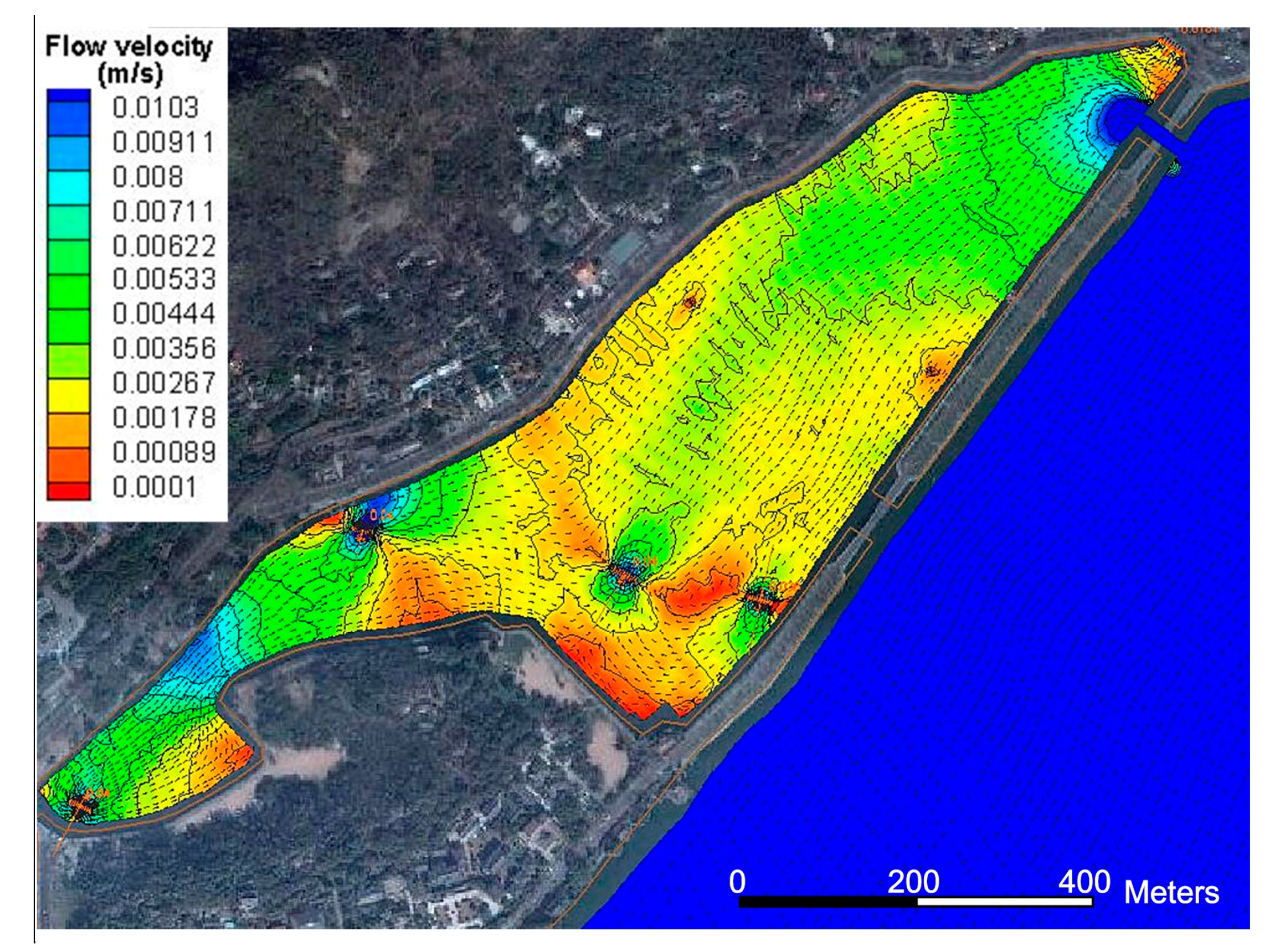
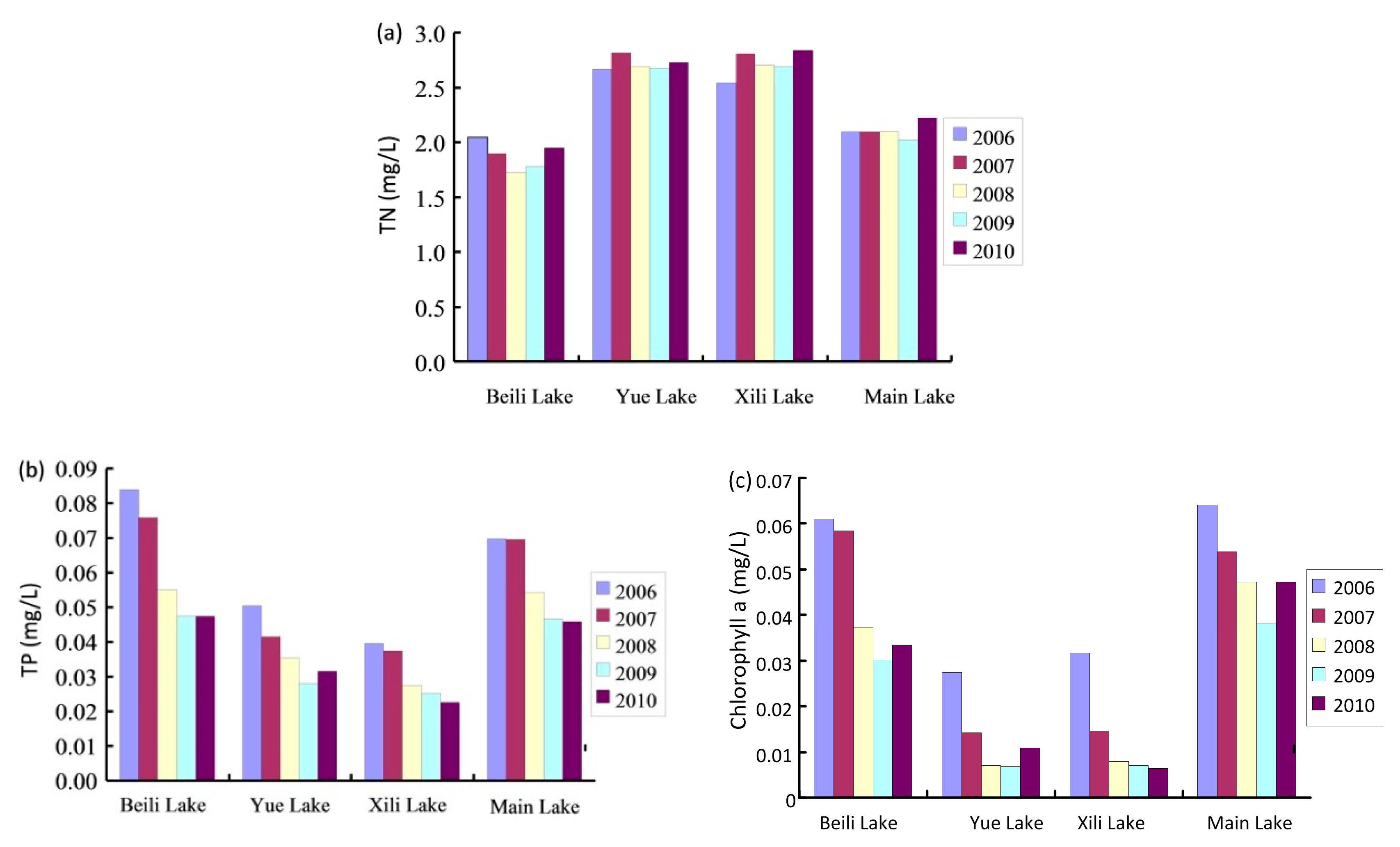
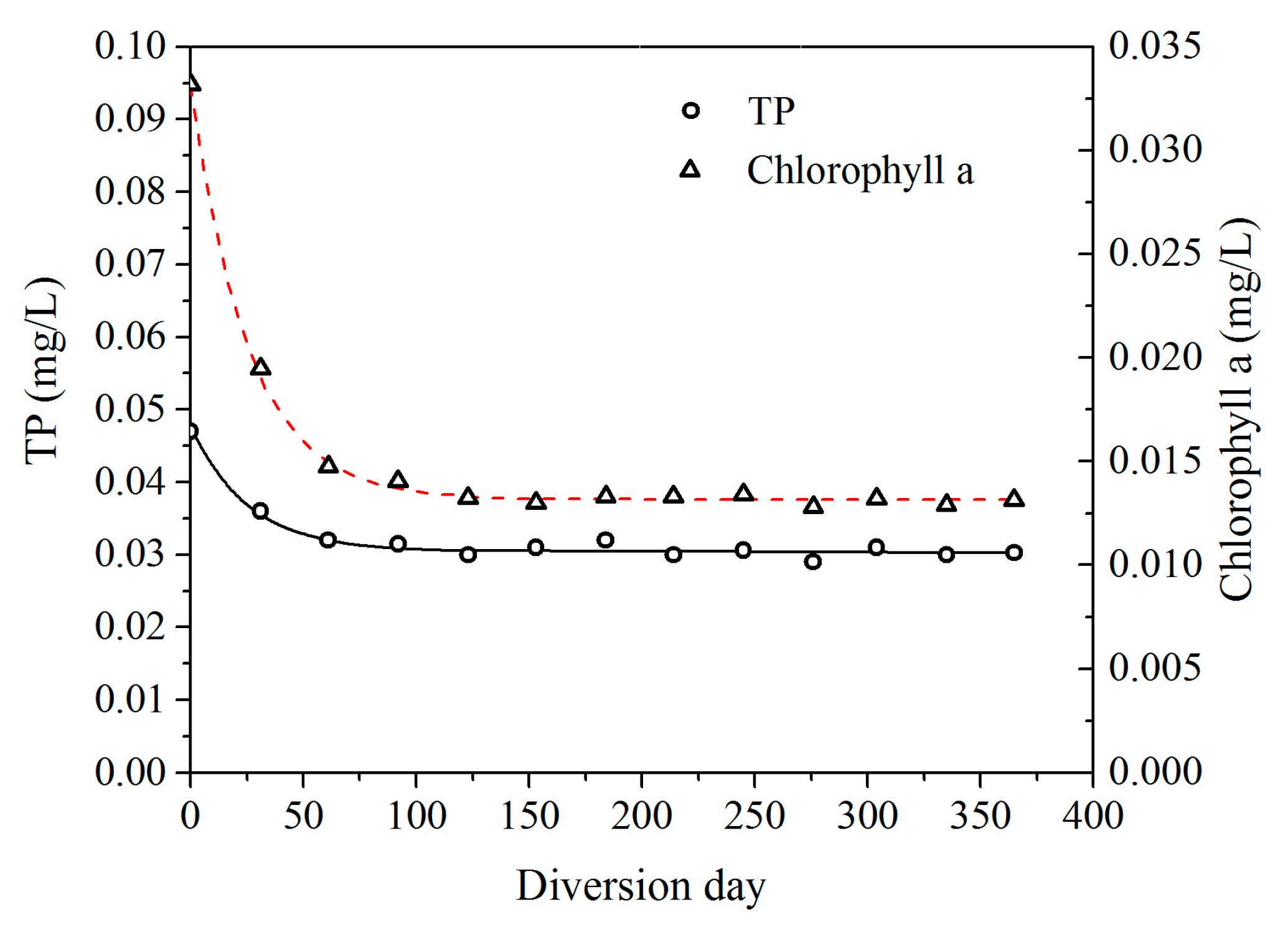
| Outlets | Inlets | ||
|---|---|---|---|
| Name | Discharge (m3/s) | Name | Discharge (m3/s) |
| Beili Lake | 0.2496 | Xiaonan Lake | 2.351 |
| Yue Lake | 0.9632 | Huangmi House | 0.22 |
| Liulang | 0.0228 | Wugui Pool | 0.285 |
| Jinniuchi | 0.0588 | Zuibai House | 0.571 |
| Yongjin Gate | 0.0604 | Changqiao Bay | 1.16 |
| Dahua | 0.0081 | ||
| Park I | 0.0859 | ||
| Park V | 0.2310 | ||
| Shengtang Gate | 3.1223 | ||
| Item No. | Classification Standard Value Items | Class I | Class II | Class III | Class IV | Class V |
|---|---|---|---|---|---|---|
| 1 | Total Phosphorus (mg/L) ≤ | 0.002 | 0.01 | 0.025 | 0.06 | 0.12 |
| 2 | Total nitrogen (mg/L) ≤ | 0.2 | 0.5 | 1.0 | 1.5 | 2.0 |
| 3 | Chlorophyll a (mg/L) ≤ | 0.001 | 0.004 | 0.01 | 0.03 | 0.065 |
| 4 | Transparency (m) ≥ | 15 | 4 | 2.5 | 1.5 | 0.5 |
| Date | Water Inlet | Beili Lake | ||||||
|---|---|---|---|---|---|---|---|---|
| Average Velocity (m/s) | Diversion Discharge (m3/s) | Average Turbidity (NTU) | Average Velocity (m/s) | Average Turbidity (NTU) | Maximum Turbidity (NTU) | Average TP (mg/L) | Average Chlorophyll a (mg/L) | |
| 22–23 July 2012 | 0.119 | 0.246 | 6.80 | 0.0051 | 13.3 | 20.1 | 0.032 | 0.015 |
| Standard deviation | 0.009 | 1.26 | 0.0028 | 2.22 | 0.0053 | 0.0025 | ||
| 10–11 September 2012 | 0.122 | 0.252 | 7.84 | 0.0053 | 12.8 | 16.1 | 0.030 | 0.013 |
| Standard deviation | 0.007 | 0.99 | 0.0025 | 1.41 | 0.0033 | 0.0014 | ||
| Date | Weather | Temperature | Wind Direction | Beaufort Scale |
|---|---|---|---|---|
| 19 July 2012 | cloudy and sunny | 27–32 °C | Eastern | 3–4 |
| 20 July 2012 | cloudy and sunny | 26–36 °C | null | 2–3 |
| 21 July 2012 | cloudy and sunny | 26–36 °C | null | 2–3 |
| 22 July 2012 (Obs.) | cloudy and sunny | 27–36 °C | East-South | 3–4 |
| 23 July 2012 (Obs.) | sunny and cloudy | 27–34 °C | East-South | 3–4 |
| 7 September 2012 | shower to cloudy | 23–29 °C | East | 6–7 |
| 8 September 2012 | cloudy to shower | 24–31 °C | East-North | 5–6 |
| 9 September 2012 | moderate rain to shower | 23–28 °C | East-South | 4–5 |
| 10 September 2012 (Obs.) | cloudy | 22–26 °C | East-North | 3–4 |
| 11 September 2012 (Obs.) | cloudy | 23–30 °C | Eastern | 3–4 |
© 2018 by the authors. Licensee MDPI, Basel, Switzerland. This article is an open access article distributed under the terms and conditions of the Creative Commons Attribution (CC BY) license (http://creativecommons.org/licenses/by/4.0/).
Share and Cite
Zhang, M.; Dolatshah, A.; Zhu, W.; Yu, G. Case Study on Water Quality Improvement in Xihu Lake through Diversion and Water Distribution. Water 2018, 10, 333. https://doi.org/10.3390/w10030333
Zhang M, Dolatshah A, Zhu W, Yu G. Case Study on Water Quality Improvement in Xihu Lake through Diversion and Water Distribution. Water. 2018; 10(3):333. https://doi.org/10.3390/w10030333
Chicago/Turabian StyleZhang, Minxi, Azam Dolatshah, Wenlong Zhu, and Guoliang Yu. 2018. "Case Study on Water Quality Improvement in Xihu Lake through Diversion and Water Distribution" Water 10, no. 3: 333. https://doi.org/10.3390/w10030333




